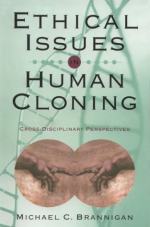|
This section contains 3,175 words (approx. 11 pages at 300 words per page) |

|
Human cloning, which occurs naturally but rarely with the birth of identical twins, became a technological possibility with the development of the technique of somatic cell nuclear transfer (SCNT) to clone the first mammal in 1996. As a result of this scientific advance, the prospect of human cloning quickly became a hotly debated ethical issue. As the debate developed it also became common to distinguish reproductive cloning from therapeutic cloning, each being subject to slightly different ethical assessments.
History and Science
Cloning (from the Greek word klon, a twig or slip) is a natural process of asexual reproduction found in many plants and some animals. When strawberry plants send out runners that set roots and turn into new plants, this is an example of a plant naturally cloning itself. Even artificial cloning is not entirely new. For hundreds of years gardeners have taken slips (small shoots or...
|
This section contains 3,175 words (approx. 11 pages at 300 words per page) |

|


